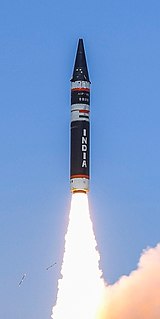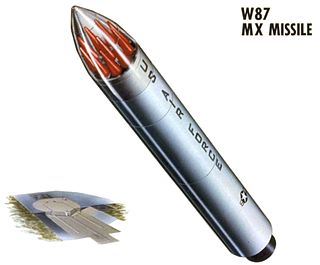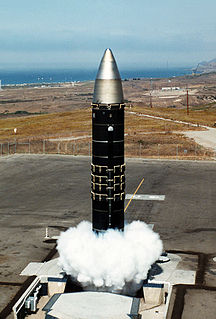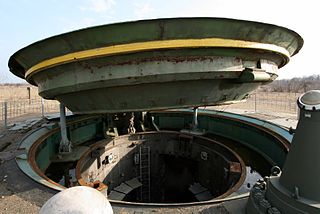Related Research Articles

An intercontinental ballistic missile (ICBM) is a missile with a minimum range of 5,500 kilometres (3,400 mi) primarily designed for nuclear weapons delivery. Similarly, conventional, chemical, and biological weapons can also be delivered with varying effectiveness, but have never been deployed on ICBMs. Most modern designs support multiple independently targetable reentry vehicles (MIRVs), allowing a single missile to carry several warheads, each of which can strike a different target. India, Russia, the United States, China, and France are the only countries that have operational ICBMs.

The LGM-30 Minuteman is a U.S. land-based intercontinental ballistic missile (ICBM) in service with the Air Force Global Strike Command. As of 2021, the LGM-30G Minuteman III version is the only land-based ICBM in service in the United States and represents the land leg of the U.S. nuclear triad, along with the Trident submarine-launched ballistic missile (SLBM) and nuclear weapons carried by long-range strategic bombers.

A multiple independently targetable reentry vehicle (MIRV) is an exoatmospheric ballistic missile payload containing several warheads, each capable of being aimed to hit a different target. The concept is almost invariably associated with intercontinental ballistic missiles carrying thermonuclear warheads, even if not strictly being limited to them. By contrast, a unitary warhead is a single warhead on a single missile. An intermediate case is the multiple reentry vehicle (MRV) missile which carries several warheads which are dispersed but not individually aimed. Only the United States, the United Kingdom, France, Russia and China are currently confirmed to possess functional MIRV missile systems. Pakistan and India are developing MIRV missile systems. Israel is suspected to possess or be in the process of developing MIRVs.

Vandenberg Space Force Base, previously Vandenberg Air Force Base, is a United States Space Force Base located 14.8 km (9.2 mi) northwest of Lompoc, California. Established in 1941, Vandenberg Space Force Base is a space launch base, launching spacecraft from the Western Range, and also performs missile testing. The United States Space Force's Space Launch Delta 30 serves as the host delta for the base. In addition to its military space launch mission, Vandenberg Space Force Base also performs space launches for civil and commercial space entities, such as NASA and SpaceX.

The LGM-118 Peacekeeper, originally known as the MX for "Missile, Experimental", was a MIRV-capable intercontinental ballistic missile (ICBM) produced and deployed by the United States from 1985 to 2005. The missile could carry up to 12 Mk.21 reentry vehicles, although treaty-limited to 10, each armed with a 300-kiloton W87 warhead. Initially, 100 MX ICBMs were planned to be built and deployed, but budgetary concerns eliminated the final procurement and only 50 entered service. Disarmament treaties signed after the Peacekeeper's development concluded in its eventual withdrawal from service in 2005.

START II was a bilateral treaty between the United States and Russia on the Reduction and Limitation of Strategic Offensive Arms. It was signed by US President George H. W. Bush and Russian President Boris Yeltsin on 3 January 1993, banning the use of multiple independently targetable re-entry vehicles (MIRVs) on intercontinental ballistic missiles (ICBMs). Hence, it is often cited as the De-MIRV-ing Agreement. Despite negotiations, it never entered into effect. It was ratified by the US Senate on 26 January 1996 with a vote of 87–4. Although Russia ratified START II on 14 April 2000, it withdrew from the treaty on 14 June 2002 in response to US withdrawal from the ABM Treaty.

The R-36 is a family of intercontinental ballistic missiles (ICBMs) and space launch vehicles (Tsyklon) designed by the Soviet Union during the Cold War. The original R-36 was deployed under the GRAU index 8K67 and was given the NATO reporting name SS-9 Scarp. It was able to carry three warheads and was the first Soviet MRV(multiple reentry vehicle) missile. The later version, the R-36M was produced under the GRAU designations 15A14 and 15A18 and was given the NATO reporting name SS-18 Satan. This missile was viewed by certain United States analysts as giving the Soviet Union first strike advantage over the U.S., particularly because of its rapid silo-reload ability, very heavy throw weight and extremely large number of re-entry vehicles. Some versions of the R-36M were deployed with 10 warheads and up to 40 penetration aids and the missile's high throw-weight made it theoretically capable of carrying more warheads or penetration aids. Contemporary U.S. missiles, such as the Minuteman III, carried up to three warheads at most.

The RT-2PM Topol is a mobile intercontinental ballistic missile designed in the Soviet Union and in service with Russia's Strategic Missile Troops. By the early 2020s, all SS-25 ICBMs will be replaced by versions of Topol-M.

The UR-100 was an intercontinental ballistic missile (ICBM) developed and deployed by the Soviet Union from 1966 to 1996. UR (УР) in its designation stood for Universal Rocket. It was known during the Cold War by the NATO reporting name SS-11 Sego and internally by the GRAU index 8K84. The Strela and Rokot carrier rockets are based on it.

The MGM-134A Midgetman, also known as the Small Intercontinental Ballistic Missile (SICBM), was an intercontinental ballistic missile developed by the United States Air Force. The system was mobile and could be set up rapidly, allowing it to move to a new firing location after learning of an enemy missile launch. To attack the weapon, the enemy would have to blanket the area around its last known location with multiple warheads, using up a large percentage of their force for limited gains and no guarantee that all of the missiles would be destroyed. In such a scenario, the U.S. would retain enough of their forces for a successful counterstrike, thereby maintaining a deterrence.
This is a chronology of the LGM-30 Minuteman intercontinental ballistic missile, acquisition and operational.

A missile launch facility, also known as an underground missile silo, launch facility (LF), or nuclear silo, is a vertical cylindrical structure constructed underground, for the storage and launching of intercontinental ballistic missiles (ICBMs), intermediate-range ballistic missiles (IRBMs), medium-range ballistic missiles (MRBMs). Similar facilities can used for anti-ballistic missiles (ABMs).
A missile combat crew (MCC), is a team of highly trained specialists, often called missileers, staffing Intermediate Range and Intercontinental ballistic missile systems. In the United States, men and women, officially coded as Nuclear and Missile Operations Officers, of the United States Air Force, operate underground missile systems at launch control centers located throughout the country. There are also a select few missileers that have the chance to become part of a Missile Combat Crew-Airborne (MCC-A) operating the Airborne Launch Control System which provides a survivable launch capability for the Minuteman ICBM force. Crew size varied among the different missile systems, but the number was always greater than one, to abide by USSTRATCOM's Two-man rule for positive control of nuclear weapons.
Simulated Electronic Launch Minuteman (SELM) is a method used by the United States Air Force to verify the reliability of the LGM-30 Minuteman intercontinental ballistic missile. SELM replaces key components at the Launch Control Center to allow a physical "keyturn" by missile combat crew members. This test allows end-to-end verification in the ICBM launch process.
Simulated Electronic Launch Peacekeeper (SELP) was a method used by the United States Air Force to verify the reliability of the LGM-118A Peacekeeper intercontinental ballistic missile.

The Peacekeeper Rail Garrison was a railcar-launched ICBM that was developed by the United States Air Force during the 1980s as part of a plan to place fifty MGM-118A Peacekeeper intercontinental ballistic missiles on the rail network of the United States. The railcars were intended, in case of increased threat of nuclear war, to be deployed onto the nation's rail network to avoid being destroyed by a first strike counterforce attack by the Soviet Union. However, the plan was cancelled as part of defense cutbacks following the end of the Cold War, and the Peacekeeper missiles were installed in silo launchers as LGM-118s instead.
In nuclear strategy, a counterforce target is one that has a military value, such as a launch silo for intercontinental ballistic missiles, an airbase at which nuclear-armed bombers are stationed, a homeport for ballistic missile submarines, or a command and control installation.

STRAT-X, or Strategic-Experimental, was a U.S. government-sponsored study conducted during 1966 and 1967 that comprehensively analyzed the potential future of the U.S. nuclear deterrent force. At the time, the Soviet Union was making significant strides in nuclear weapons delivery, and also constructing anti-ballistic missile defenses to protect strategic facilities. To address a potential technological gap between the two superpowers, U.S. Secretary of Defense Robert McNamara entrusted the classified STRAT-X study to the Institute for Defense Analyses, which compiled a twenty-volume report in nine months. The report looked into more than one hundred different weapons systems, ultimately resulting in the MGM-134 Midgetman and LGM-118 Peacekeeper intercontinental ballistic missiles, the Ohio-class submarines, and the Trident submarine-launched ballistic missiles, among others. Journalists have regarded STRAT-X as a major influence on the course of U.S. nuclear policy.
References
Notes
Bibliography
- Auten, Brian J. (2008). Carter's Conversion: the hardening of American defense policy . Columbia, MO: University of Missouri Press. p. 42. ISBN 978-0-8262-1816-2 . Retrieved 7 December 2010.
- Edwards, Joshua S. (20 September 2005). "Peacekeeper missile mission ends during ceremony". United States Air Force. Archived from the original on 10 February 2012. Retrieved 7 December 2010.
- Friedman, Norman (1994). US Submarines Since 1945: An Illustrated Design History. Annapolis, MD: Naval Institute Press. ISBN 1557502609.
- Hartunian, Richard (2003). "Ballistic Missiles and Reentry Systems: The Critical Years". Crosslink. Directory of U.S. Military Rockets and Missiles. El Segundo, CA: The Aerospace Company. Archived from the original on 5 March 2012. Retrieved 7 December 2010.
- Parsch, Andreas (2003). "BGM-75 AICBM". Directory of U.S. Military Rockets and Missiles. designation-systems.net. Archived from the original on 15 December 2010. Retrieved 7 December 2010.
- Parsch, Andreas (2009). "Current Designations of U.S. Unmanned Military Aerospace Vehicles". designation-systems.net. Retrieved 10 December 2010.
- Tammen, Ronald L. (1973). MIRV and the Arms Race: An Interpretration of Defense Strategy. Westport, CT: Praeger. ASIN B000JNG51G.